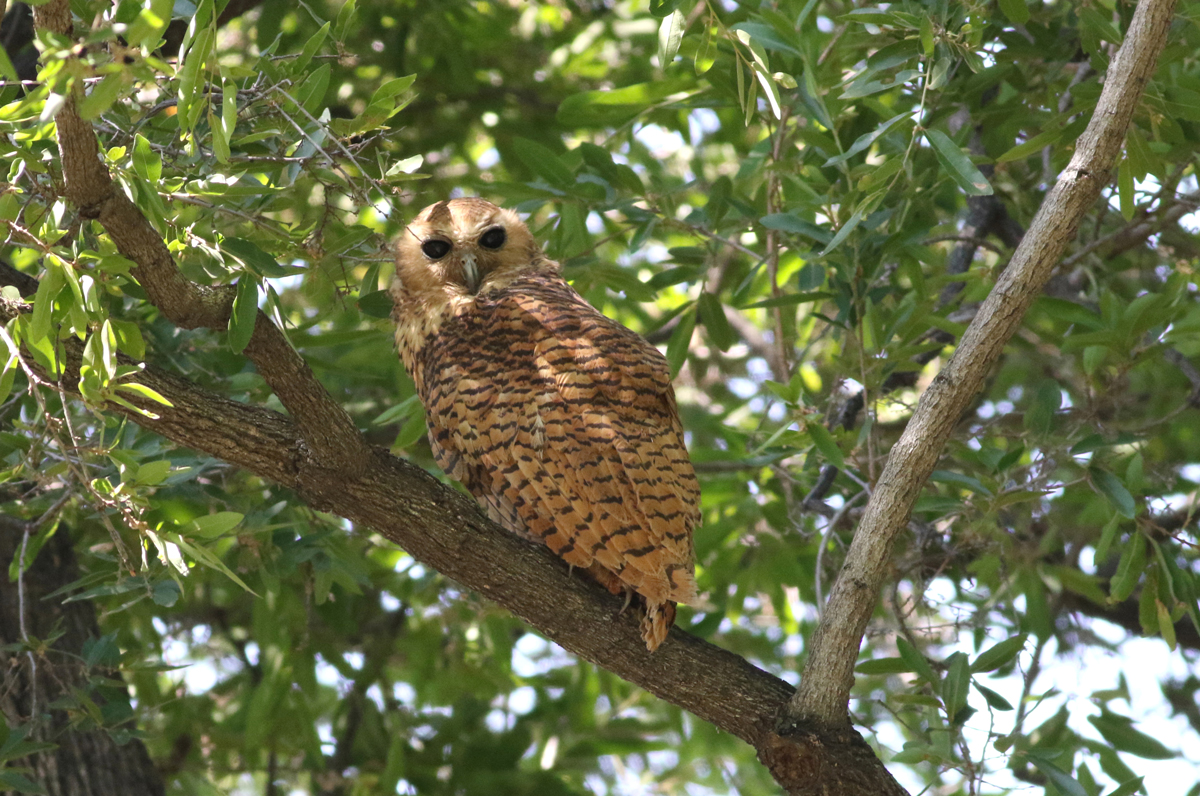
Main Tour Dates: Thursday 28th October – Tuesday 11th November 2025 (Walvis Bay Namibia to Livingstone Zambia)
Tour Price: £5,299pp plus flight
Estimated Flight Price: London to Walvis Bay and out of Livingstone approx. £1,100 return
Deposit: £700 per per person
Conservation Donation from Wise Birding: £150 – £200
Minimum Number: 6 people
Maximum Group Size: 7 people
Target Birds:
Rupell’s Parrot, Hartlaub’s Spurfowl, Monteiro’s Hornbill, Bradfield’s Hornbill, Rupell’s Korhaan, Secretary Bird, Wattled Crane, Slaty Egret, White-backed Night-Heron, Chestnut-Banded Plover, White-tailed Shrike, Rockrunner, Rufous-eared Warbler, Cinnamon-breasted Warbler, Rosy-faced Lovebird, Racket-tailed Roller, Verreaux’s Eagle, Verreaux’s Eagle Owl, Pel’s Fishing Owl, Herero Chat, Bare-cheeked Babbler, Rufous-bellied Tit, Souza’s Shrike, Chestnut-vented Warbler, Carp’s Tit, Chirping Cisticola, Luapula CisticolaDune Lark, Pink-billed Lark, Gray’s Lark, Benguela and Karoo Long-billed Larks, Namaqua Sandgrouse and many many more!
Target Mammals:
Spotted Hyena, African Wild Cat, Cheetah, Lion, Leopard, Hartmann’s and Plains Zebra, Eland, Honey Badger, Aardvark, Bat-Eared Fox, Aardwolf, Black Rhino, Oryx, Klipspringer, Roan Antelope, Southern Lechwe, Sitatunga and many more!
Tour Summary
Namibia is a country of vast open space, superb scenery, great accommodation and simply fantastic birds and mammals. This itinerary spends a total of 11 nights in Namibia, 2 nights in Botswana and our final night in Zimbabwe at Victoria Falls! The focus of the tour is on finding Namibia’s near endemic speciality birds and Namibia’s one true endemic, the enigmatic Dune Lark. Of course, we will not be ignoring the other fabulous wildlife to be found in these three countries and we will also savour a wonderful number of special mammals too. Quite simply, if you want to see a great selection of birds and mammals in one of the world’s great wilderness areas, then this is the tour for you.
We should see close to 400 species of birds and up to 50 species of mammal.
Tour Report from a very similar itinerary from 2016 HERE
ACCOMMODATION: 11 nights in Namibia, 2 nights in Botswana and 1 night in Zimbabwe
2 nights Walvis Bay, 1 night Erongo Mountains, 1 night Brandberg Mountain, 1 night Kaokoland, 3 nights Etosha NP, 1 night Mahango Park, 2 nights Okavango Pan Handle (Botswana), 2 nights Namushasha River, 1 night Victoria Falls (Zimbabwe).
Inclusive Meals: Full board from dinner on day 1 to dinner on day 14
Inclusive Activities: All Game drives, night drive and boat trips listed below
DAY 1: Arrival Walvis Bay
Resting on Namibia’s spectacular coastline just south of Swakopmund, Walvis Bay (Whale Bay) is a thriving town, Namibia’s principal harbour and one of the country’s most popular tourist centres. It is known for its natural lagoon, striking orange sand dunes and wealth of wildlife. We should arrive into Walvis Bay airport during the afternoon and will be met by our local guide and we will begin our birding around the famous lagoon. Here, the sheer numbers of waders are impressive and in addition to a vast array of familiar Palearctic waders we should also find other species such as African Oystercatcher, White-fronted and the very smart Chestnut-banded Plover. A look off the coast should reveal a nice mix of terns including Great Crested and the localised Damara Tern. There will certainly be plenty of variety to keep us busy for our first easy afternoon of birding. We will spend the night at a wonderful hotel which has beautiful views over the lagoon where spectacular sunsets and Flamingos welcome us!. Overnight Flamingo Villas Boutique Hotel
DAY 2: Walvis Bay Coast and Dunes
This morning we will head out early into the famous sand dunes where we will be searching for Namibia’s only true endemic, the understated and niche Dune Lark. After our success with the lark we will take in the impressive views across the start of the immense dune system and then return to the coast hopefully picking up Gray’s Lark and Tractrac Chat en route, before spending the rest of the day exploring the coast. The internationally important Walvis Bay lagoon will draw us in to enjoy more time sifting through the huge numbers of waders that are found here and we will have time to enjoy the spectacular numbers of Greater and Lesser Flamingos. Offshore, Cape, Bank, Crowned and Great Cormorants should be easy to find alongside commoner species like Great White Pelican, Hartlaub’s and Grey-hooded Gulls. After lunch, some further time exploring sites along the coast will give chances for many more new species such as Augur Buzzard, Pale Chanting Goshawk, Red-capped Lark, Cape Sparrow and Orange River White-eye. Overnight Flamingo Villas Boutique Hotel
DAY 3: Walvis Bay to the Erongo Mountains
After breakfast we will travel North-East towards the Erongo Mountains. We will make a few stops en route as we are likely to encounter many new birds and new mammals today. We will be looking for Rüppell’s Parrot, Rosy-faced Lovebirds, Violet Wood Hoopoe, Verreaux’s Eagle, Chestnut-vented Warbler and the near endemic Herero Chat and the superb White-tailed Shrike. The Erongo Mountains are the best place in Namibia to try and see Black Mongoose and we might just get lucky with this highly sought after species. We will be staying at the fabulous Ondudu Safari Lodge, nestled amongst the rugged granite koppies (hills) of the lower Erongo Mountains. The lodge is the founding member of the 2,000 square kilometre Erongo Mountain Nature Conservancy, which brings together 30 private landowners in an effort to conserve this diverse habitats of this region. Birds in and around the lodge include many specialities of the area such as Rockrunner, Short-toed Rock Thrush, Barred Wren Warbler and Freckled Nightjars at dusk. Overnight Ondudu Safari Lodge, Erongo Mountains
DAY 4: Erongo Mountains to Brandberg Mountain
Today we travel just a couple of hours west to search for the Benguela Long-billed Lark and there is also another chance for the Herero Chat. Mammals to keep an eye out for will be species such as Hartmann’s Zebra, Klipspringer and with great luck, there is a chance of Desert-adapted Elephants too. We will make a number of birding stops en route to the small settlement of Uis which will be our base for the night. It lies at the foot of Namibia’s highest mountain, the Brandenberg and the site of the White Lady rock painting thought to be over 20,000 years old. The Uis River, which passes through the town, provides a welcome place for birds to drink and we will check this area for Carp’s Tit, a chance for the boisterous Bare-cheeked Babbler and maybe Olive Bee-Eater too. During the afternoon we will do some birding in the nearby area where we will look for species such as Karoo Long-billed Lark, Mountain Wheatear, Karoo Chat, Ludwig’s Bustard and a good selection of birds of prey. Overnight Uis Elephant Guesthouse
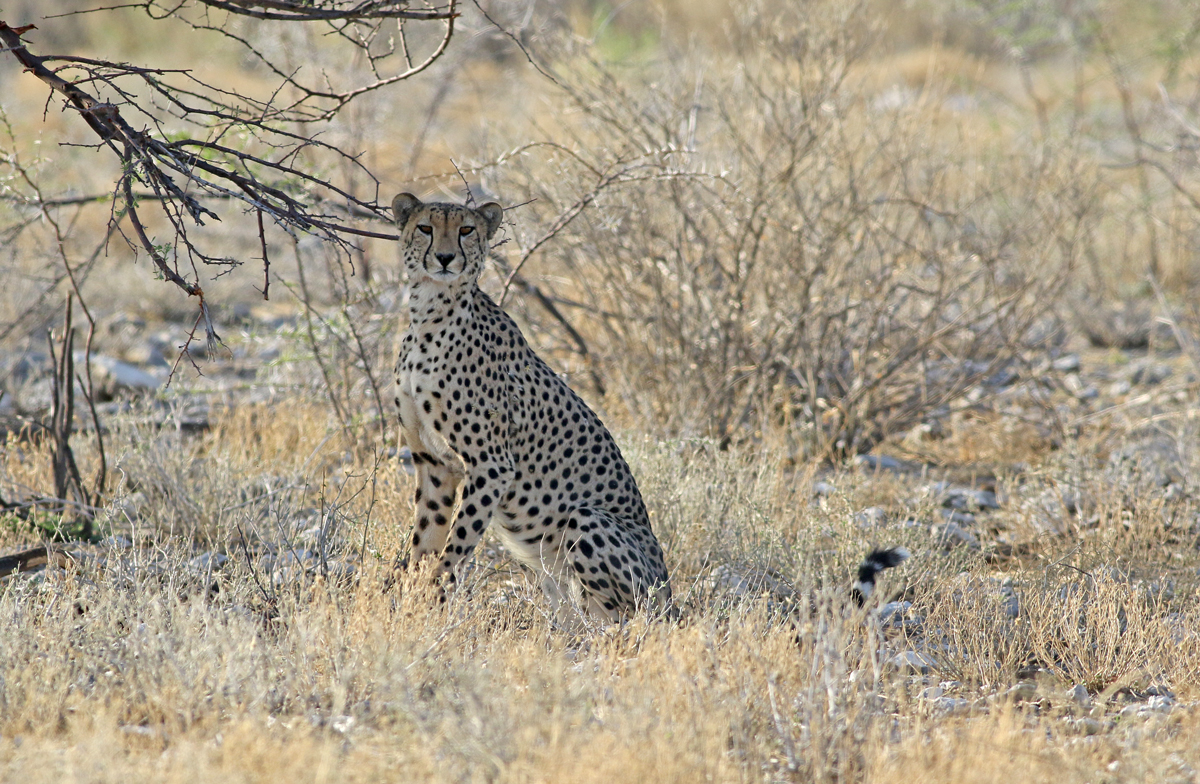
Cheetah, Etosha NP by Chris Townend
DAY 5: Uis to Hobatere, Etosha West
Once again we will set off early as we head north through the Galton Gate towards the western edge and the wilder part of the famous Etosha National Park. Here, we will explore the magnificent scenery of this remote north Namibian landscape characterised by lush undulating terrain and a reddish-brown soil, which is a stark contrast to the white dusty clay soil of Etosha East’s flat expansive plains. Our destination is Hobatere Lodge, located 80 km north of Kamanjab on the western border of the Etosha National park, situated in a concession area of 32 000 ha. Raptors are well represented here and we should find Yellow-billed Kite, Brown Snake Eagle and Black-chested Snake Eagle, Tawny Eagle and Wahlberg’s Eagle, African Hawk-Eagle, Augur Buzzard, Gabar Goshawk, Shikra and Little Sparrowhawk. We should also find Acacia Pied Barbet, Golden-tailed, Woodpecker, Red-billed Buffalo Weaver, Southern Masked Weaver and Chestnut Weaver, Red-billed Quelea (often by the thousand!), Yellow Canary, and Cinnamon-breasted Bunting. The land surrounding the lodge has many exciting mammals including Leopard, Lion, Cheetah, Elephant and Eland, but it is the nocturnal species that are particularly special and we will take a night drive here to specifically look for the more difficult but highly prized species such as Bat-eared Fox, Aardwolf and Aardvark! Overnight Hobatere Lodge
DAY 6: Hobatere to Okaukuejo – Etosha South
Located just south of the boundary of Etosha National Park, Etosha South makes up the southern region of this wildlife paradise. We will access the park through the southern entrance at Andersson’s Gate.
Etosha National Park covers nearly 23,000 square kilometres and is justly famous as one of the finest game reserves in Africa, immortalised in many wildlife films. The name ‘Etosha’ means ‘Big White Place’ in the language of the local Bushmen. Covering such a large area, the park naturally encompasses a varied selection of habitats and an unusually high diversity of birds and mammals. Etosha is also home to an abundance of ground loving bird species such as Northern Black Korhaan, Red-crested Korhaan, Double-banded Courser and numerous Lark species, including the localised Pink-billed Lark and aptly-named Spike-heeled Lark. For most of the year the area is very dry, ranging from near desert in the west to dried-out lake beds in the central sector and well developed woodland in the moister east, but the many waterholes act as a magnet for mammals and birds during the drier months. We will spend the whole day birding the park and the lodge garden which can often attract numerous species to the waterhole within the grounds. Outside of the lodge we will explore further to look for species such as Rufous-eared Warbler, Red-necked Falcon and Blue Crane as well as enjoying the numerous mammals including Elephant, Giraffe, Spotted Hyena and an abundance of Antelopes and other game. In the evening, we have an excellent chance of seeing Black Rhino from the grounds of our accommodation overlooking a fantastic waterhole. This is probably the best place in Namibia to see Black Rhino which visit regularly, along with Elephants and Lions. Nocturnal birds are also well represented with Verreaux’s Eagle Owl and Rufous-cheeked Nightjar regularly seen by floodlight. Overnight Okaukuejo Resort
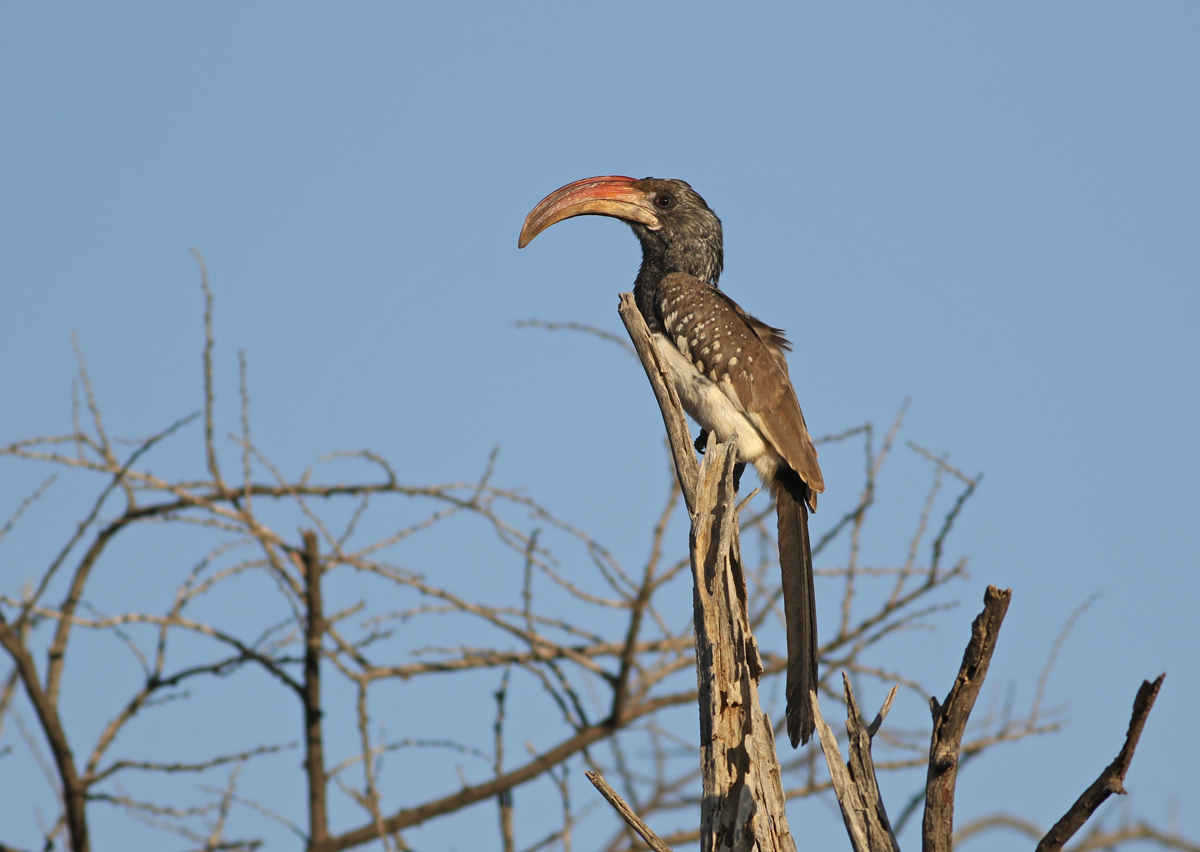
Monteiro’s Hornbill, Namibia by Chris Townend
DAY 7: Halali Resort, Etosha Central
We will travel to Halali Camp, located in the centre of the park and numerous birding stops along the route. The species we may see are many and could include species such as African Quail finch, Red-necked Falcon, Blue Crane, Ostrich, Secretary Bird, Spike-heeled Lark, Pink-billed Lark and hopefully Southern Pied Babbler. Once at Halali, we will search for day roosting African Scops Owl and Southern White-faced Scops Owl, both of which are regularly found within the camp grounds. The camp is situated at the base of a dolomite hill, nestled amongst shady Mopane trees and is a nice place to spend the hotter part of the day as birds visit the gardens. We can spend some of the evening at the floodlit waterhole as sightings of Leopard are not uncommon. During the evening we will also take a night drive within the National Park to look for the harder to see species like Aardwolf and sometimes even the highly elusive Caracal can be seen. We will return to the lodge late, but for those still keen for more there is always the floodlit waterhole! Halali lodge is also one of the best places to see Honey Badger with animals often visiting the camp grounds looking for any scraps of food. Overnight Halali Camp
DAY 8: Full day Etosha Central / West
Today we will take a slow drive towards Namutoni where we will explore the eastern side of the park. Birds likely to be found en route include Kori Bustard, Burchell’s Courser, Temminck’s Courser, Double-banded Courser and Double-banded Sandgrouse. We will also spend time looking for species that prefer the wooded Acacia and partial cover like Red-billed Spurfowl, Red-crested Korhaan, Monotonous Lark, Crimson-breasted Shrike, Southern White-crowned Shrike, Kalahari Scrub Robin, Southern Pied Babbler, Bare-cheeked Babbler, Barred Wren Warbler, Burnt-necked Eremomela, Marico Flycatcher, White-bellied Sunbird, Cape Penduline Tit, Pririt Batis, Scaly-feathered Weaver, Violet-eared Waxbill, Shaft-tailed Whydah, Cape Starling and Burchell’s Starling. Wherever trees are large enough to support their massive nests, we should find Sociable Weavers and the associated tiny Pygmy Falcons may also occur.
During the afternoon we will take a run to the plains north of Namutoni and search for other thornveld species en route, Swallow-tailed Bee-eaters, numerous Waxbills including the beautiful Violet-eared Waxbill, Yellow Canary, Brubru, and on the Andoni plains we will look out for Eastern Clapper Lark and Kittlitz’s Plover. Of course mammals will also play a large part of our day as some of the most popular waterholes of the park are located in close proximity to Halali. We should enjoy the spectacle of many animals visiting the busy waterholes around the Park as we look for species like Oryx, Elephant, Giraffe, Waterbuck, Spotted Hyena, Steenbok and many more! Overnight Halali Camp
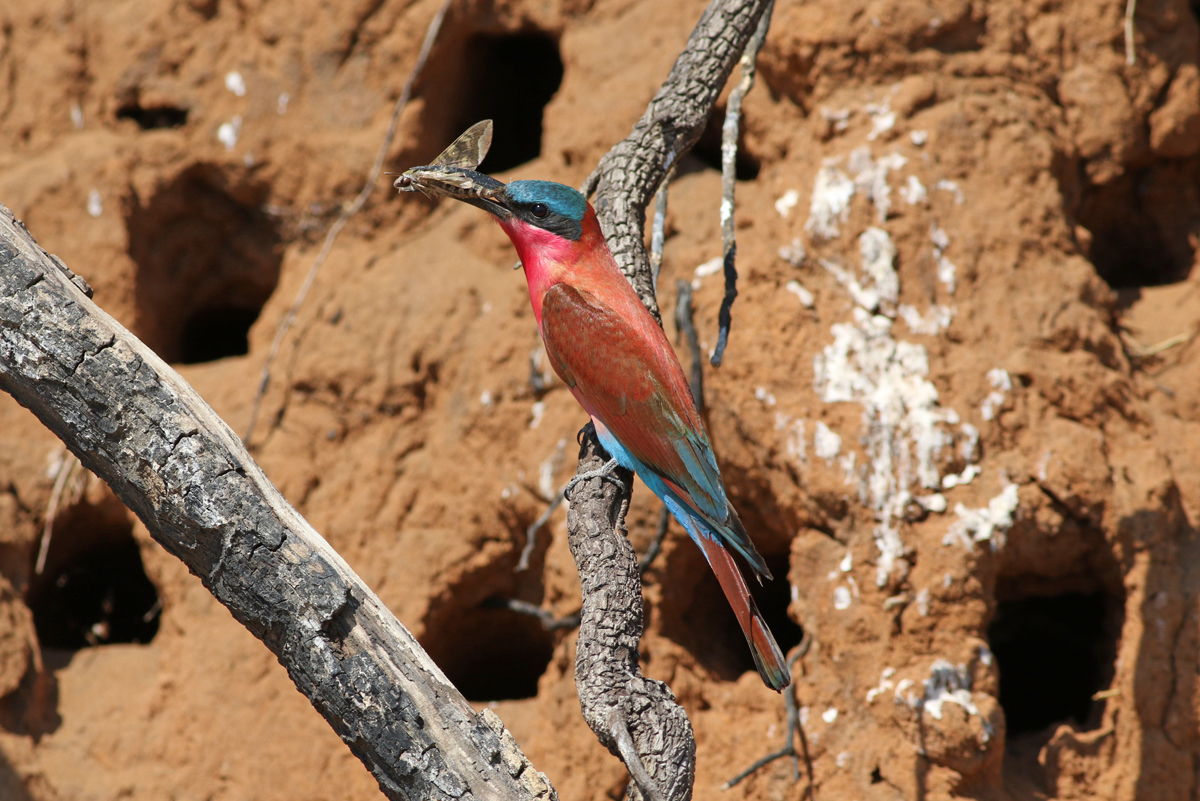
Southern Carmine Bee-Eater, Botswana by Chris Townend
DAY 9: Etosha to Mahangu Safari Lodge, Divundu
After breakfast we wave goodbye to Etosha and head for our accommodation east of the town of Rundu in the far north of the country. Set roughly 200 kilometres east of Rundu on the southeastern banks of the great Okavango River, the small village of Divundu is a wonderful destination from which to explore the river, game parks and national reserves of the area. During our day travelling, we will try for the range restricted Black-faced Babbler and see the habitat change from dry Mopane woodland to tropical palm savannah and by the end of the day we will be birding in Teak forest which closely resembles the Miombo woodlands found further north in Africa. South of Rundu we enter a different biome with broad-leafed woodland and it is here that the real birding begins! This is ideal habitat for specialities such as Rufous-bellied Tit and Souza’s Shrike as well as Tinkling Cisticola, African Golden Oriole, Southern Yellow White-Eye and Southern Black Tit and our first chance of Dark Chanting Goshawk. As we travel to the east of Rundu we will stop and search for Racket-tailed Roller, Southern Black Flycatcher, Black-headed and African Golden Orioles and Kurrichane Thrush. We may also spot some Accipiters such as Gabar Goshawk and Shikra en route. We will reach our lodge on the Kavango River where we will take an afternoon boat cruise. Being on the river will allow great views of waterbirds as we search for species such as Slaty Egret, Rock Pratincole, African Skimmer and maybe a Spotted-necked Otter. After dinner we will do some Owling where our targets will be African Wood Owl and Southern White-faced Scops Owl. Overnight Mahangu Safari Lodge
DAY 10: Divundu to Botswana and Drotsky’s Cabins, Okavango Panhandle
This morning we travel to Botswana and take a scenic riverside drive through the moist grassland, wetlands, open plains and riparian vegetation of Mahango Game Reserve. After clearing customs and immigration we will set off into Botswana to our accommodation at Drotsky’s Cabins on the western panhandle of the Okavango Delta, near Shakawe in the northwestern corner of Botswana. The papyrus channels and lush vegetation of the river make the cabins a perfect venue for birding. This whole area is a must visit place if you are a birder. Species we will be looking for include the Pel’s Fishing Owl, Southern Carmine Bee-eater, Brown Fire-finch, Swamp Boubou, Slaty Egret, Lesser Jacana, Wattled Crane, White-backed Night-Heron, Chirping Cisticola, Luapula Cisticola, Greater Swamp-warbler, Coppery-tailed Coucal, Allen’s Gallinule and many more. Overnight Drotsky’s Cabins
DAY 11 Full day on the Okavango River
Today we will devote the full day to a morning and afternoon river cruise. The Okavango Panhandle is situated in the northwestern area of the Okavango Delta and is a stretch of the Okavango River that follows a more-or-less straight course for approximately 70 kilometres before entering the wetlands. This deep channel serves as the main water source feeding the delta, while the surrounding woodlands and the river’s shallow waters teem with birdlife. Several villages are also dotted along the river as a gateway to the scenic Tsodilo Hills famous for their tribal cave paintings, some dating back as far as 20,000 years. During our boat trips, we will be searching for the secretive White-backed Night Heron, Wattled Cranes, African Skimmer and we have two chances to see the superb Pel’s Fishing Owl. Of course we will also be looking for many other species too such as Greater and Lesser Swamp Warbler, Little Rush Warbler, African Rail, Greater Painted Snipe and African Pygmy Goose. During a break for lunch before our afternoon river cruise, we can also have time to enjoy the numerous species present around the gardens such as White-fronted Bee-Eater and Holub’s Golden Weaver. Overnight Drotsky’s Cabins
DAY 12: Pan Handle, through Bwabwata National Park to the Kwando River
Today we head back to the border control and take a slow drive through the Mahangu Reserve and through the Bwabwata National Park (formerly the Caprivi Game Park). During our journey we are sure to be distracted by numerous birds and of course more mammals. We have a good chance of seeing Dickinson’s Kestrel, Brown Snake-Eagle and a number of smaller raptors including African Cuckoo Hawk before we arrive at the Kwando River which rises from the central Angolan highlands forming the boundary between Namibia, Zambia and Angola. We should arrive by mid afternoon and will have plenty of time to bird the area hoping to find more species for our growing bird list. The Kwando River nourishes its delicate ecosystems thus sustaining the varied game and birdlife in the region. The area surrounding the Kwando River is known for its protected game reserves, national parks and wildlife sanctuaries. It offers excellent game viewing with the perennial waters of the river attracting plentiful wildlife including large herds of Elephant, Hippos, Southern Lechwe, Sitatunga, Zebra, Impala, Spotted-necked Otters and over 400 species of bird. Overnight Namushasha River Lodge
DAY 13: Full day exploring the Bwabwata National Park
We will explore the Babwata National Park which has outstanding bird watching opportunities given the variety of riverine, floodplain and grassland habitats. We will look for species such as Narina Trogon and the rare Racket-tailed Roller amongst the tall teak woodlands. Other sought-after species include Retz’s Helmet-Shrike, Emerald Cuckoo, Bradfield’s Hornbill, Black-headed Oriole, Crested Barbet and several species of woodpecker. Once again, mammals will be a big attraction and we shall search for Elephants and Buffalo, Lion, Hippo, Leopard, the extremely rare Sable Antelope, Roan Antelope and more. There is also a possibility of Wild Dog in this area. We will spend a full day exploring this amazing area focusing on the species that we have yet to find, particularly the tougher species like Black Coucal and Rosy-throated Longclaw. Overnight Namushasha River Lodge
DAY 14: Travel into Zimbabwe, Victoria Falls
We will cross the border via Botswana into Zimbabwe and take a memorable afternoon boat cruise on the mighty Zambesi River and view the Victoria Falls set on the magnificent Zambezi River which creates the border between Zambia and Zimbabwe. Considered to be the world’s widest waterfalls, Victoria Falls measures an impressive 1,708 metres in width. Of course aside from the spectacular views, we will primarily be looking for wildlife and it should be a great finale to the tour. Schalow’s Turaco and Bearded Scrub Robin will be just two of the species that we will look for on this day. We will spend our last night of the tour at the Shearwater Explorers Village located in Victoria Falls, Zimbabwe surrounded by intriguing indigenous vegetation and wildlife. The small town of Victoria Falls, which lies adjacent to the waterfalls, serves as a great base from which to explore. Overnight: Shearwater Explorers Village
DAY 15: Travel to Livingstone Airport (Zambia)
Today we take the short transfer of around 30 minutes across to Zambia and Livingstone airport where the tour concludes.
Please note this is a flexible itinerary which may need to be adjusted slightly dependent on arrival / departure times, weather conditions and the most recent information from our local guides
Leaders: Wise Birding leader plus local guide
Included in cost: Accommodation in ensuite rooms in good quality hotel/lodge accommodation. All meals, bottled water, all park entrance fees, boat trips and night drives as per itinerary, all ground transport and services of leaders.
Not included in cost: International / domestic airfare, travel insurance, drinks other than water and any airport or visa fees.
Single Supplement: £450pp
Transport: Landcruiser Safari Vehicle throughout.
Difficulty: Easy The walking throughout the tour is relatively easy going with flat terrain. Most time will be spent viewing from Jeeps.
Climate: Generally very hot and dry with temperature in the mid 30s degrees Celsius.
Tour Start Point: Walvis Bay, Namibia
Tour End Point: Livingstone, Zambia
Suggested Airlines: British Airways via Johannesburg
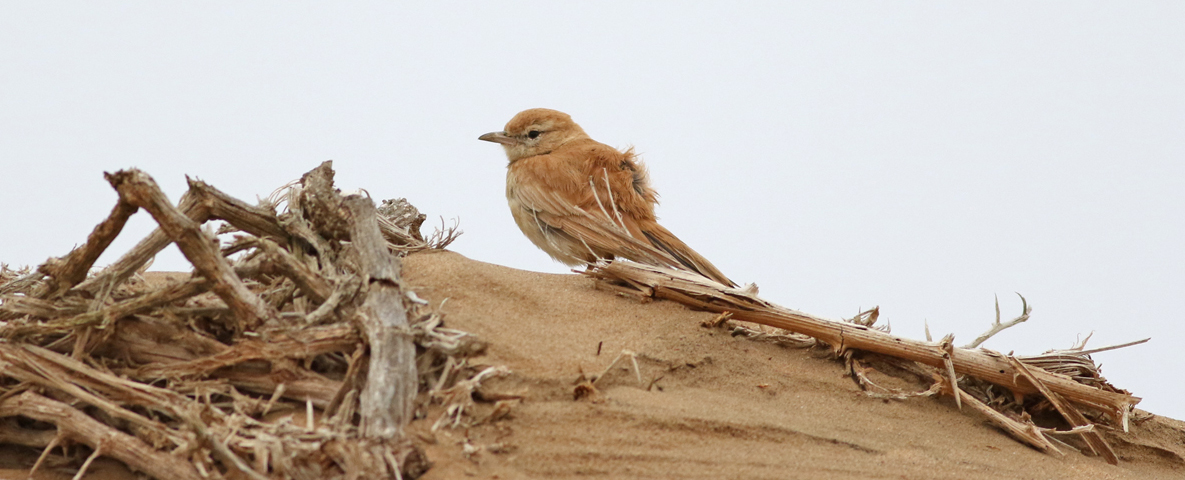
Dune Lark, Namibia by Chris Townend